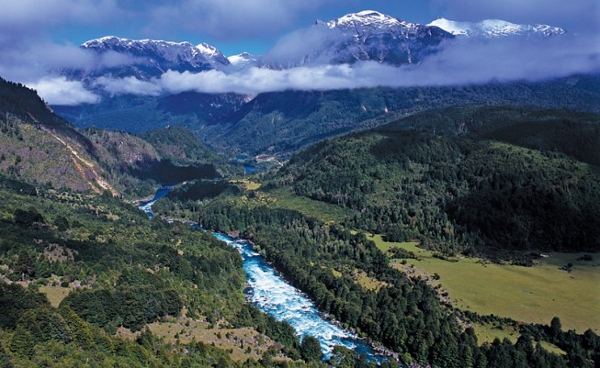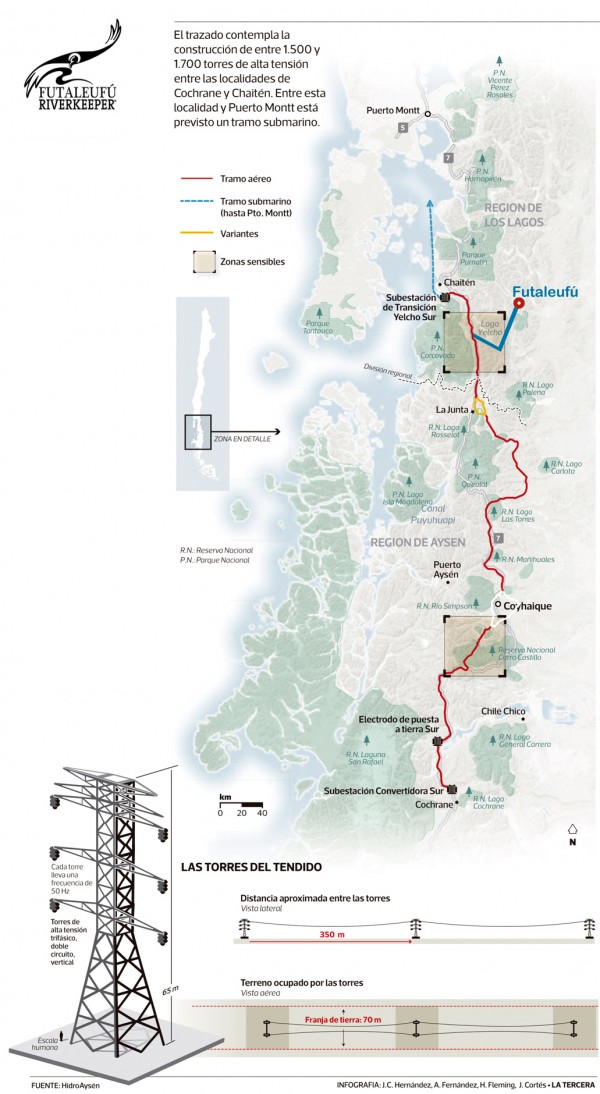AS WE’VE REPORTED over the past two years, multinational energy company Endesa owns the water rights to many of Patagonia’s largest and most pristine rivers, and has developed plans for hydroelectric megaprojects in spite of massive public opposition and legal issues. While plans for the Rio Baker are currently stalled, in early January a representative from Endesa revealed the multinational’s plans to continue advancing on the Futaleufú1.


Map of proposed transmission lines and dams in Chilean Patagonia. (Note: The full transmission line would extend north through the entire country.) Please click to enlarge. Image courtesy of www.futaleufuriverkeeper.org
As someone who has lived in the region and spent time both in the town of Futaleufú and its river valley, I can vouch for this place. Were this in the US it would be a crown-jewel national park similar to the Grand Canyon or Yosemite. The river (which actually begins in Los Alerces National Park in Argentina before crossing into Chile) has as much volume as the Grand Canyon, but with substantially more gradient and constriction, making for some of the largest commercially rafted rapids in the world.
Since the river was pioneered as a whitewater run in the late ’70s, the town has evolved into an international community and flourishing local economy based on outdoor adventure / recreation. And what’s difficult to contextualize (this was explained to me by a local restaurateur on the night of Futa’s 80th “birthday” celebration) is that the town didn’t even have modern infrastructure (read: bridges, electricity) until the mid 1980s.
Everything and everyone you’ll find in Futaleufú, from organic restaurants to locals who continue living close to the land as they have for decades, is in some way connected to the place because of the river and/or the fertility of the valley. And if the river is dammed, the valley flooded, then this corner of the world, and the lives of the people who live there (and can’t afford to relocate) will likely be ruined forever.
What the dams are actually for
It’s important to note that hydropower is not intrinsically negative. Throughout the world there exist small-scale, sustainable hydro-projects designed to intelligently fit the site and only divert part of the water instead of completely impounding / blocking flow. In this way, power can be generated in a local area while still conserving its habitat / ecosystems.
The issue with Endesa is that the projects are simply out of scale with the landscape and do not benefit anyone at the local level. Instead, proposed dams would completely block rivers, flood valleys, and send power through inefficient transmission lines over 2000km up the country to mining projects in the north.
How you can help
As I’ve written before, one of the biggest challenges this area faces is its isolation from the rest of the world. Patagonia is so “out of sight, out of mind” for most people, that it becomes difficult to understand what’s at stake. If people could only see the scale of the place, or the almost otherworldy translucent blue shades of the water there, they might be more compelled to act.
- Check out Futaleufú Riverkeeper, a Chilean environmental org launched in 2012 that’s dedicated to helping keep the Futaleufú from being destroyed.
- In a recent social media campaign kicked off by local outfitter O.A.R.S., for every new fan O.A.R.S. receives on Facebook, they will donate $1 per fan, up to $2,500. Please help raise funds for the Futaleufú by liking and then sharing the O.A.R.S. Facebook Page.
1Futalefu Riverkeeper, January 8, 2013